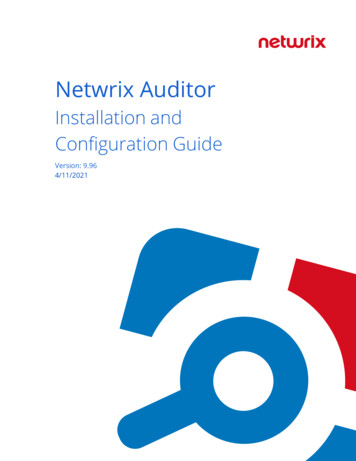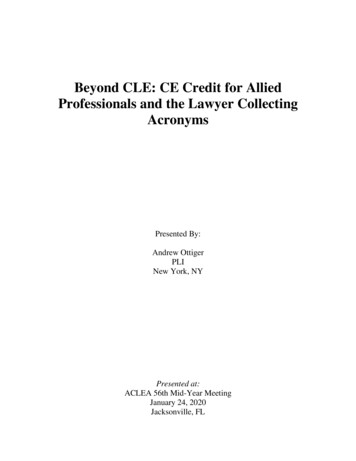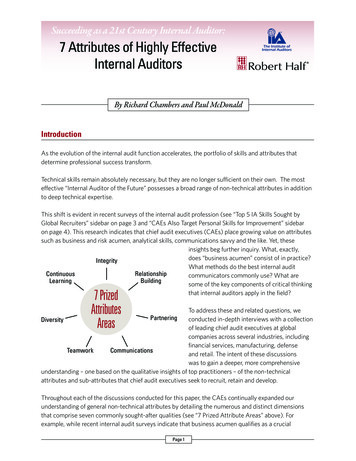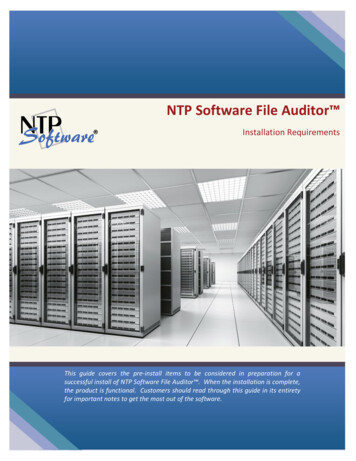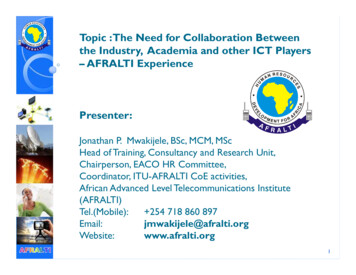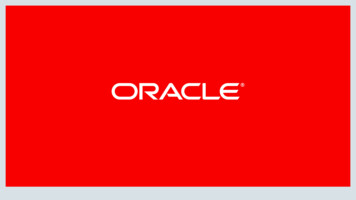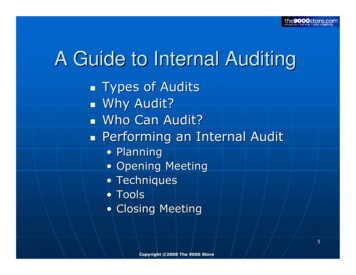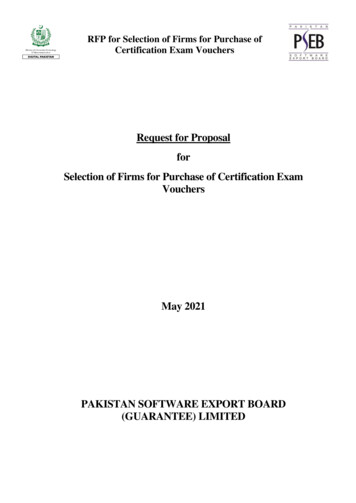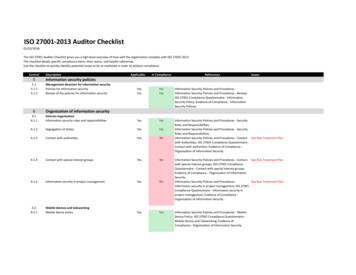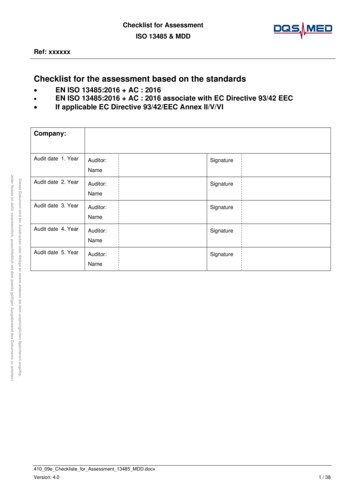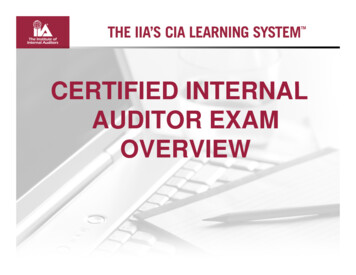
Transcription
CERTIFIED INTERNALAUDITOR EXAMOVERVIEWwww.LearnCIA.com1
Exam OverviewIt is important to note that the CIA Exam is really four exams not oneone.Accordingly, the knowledge required and preparation process will vary.Please note that my comments are my personal opinions and may ormay not reflect the position of The IIA.Part I The internal audit activity’s role in governance, risk, and control.P t2Part Conducting the internal audit engagement.Part 3 Business analysis and information technology.Part 4 Business management skills.skillswww.LearnCIA.com2
Exam equateHours2½2½2½2½Impact ofExperienceBeneficialBeneficialNot RelevantNot RelevantSuggestedhours ypically 5 to 10NoneLiterature pe Questionswww.LearnCIA.com3
Comments Grade Distribution:– The grades are typically much more compressed on parts1 and 2 than a normal distribution.– This is due to the fact that everyone is studying the samematerial and the more candidates study, the more similarthe scores.– This does not hold for part 4 since the educationalbackgrounds of the candidates may vary.www.LearnCIA.com4
Comments StatusComputer-Based TestingModel ExamResource MaterialsWaiverFuture Changeswww.LearnCIA.com5
Passing the Exam The exam is primarily a preparation processprocess. Three primary reasons that candidates do not passthe exam:– Knowledgeg of the exam coverageg and content.– Insufficient preparation.– Preparation not focused.www.LearnCIA.com6
Keys to Passing the Exam Model Exam– Candidates should purchase the Model Exam and read asthe first step in the preparation process.– The Model Exam provides a quick overview of the contentand difficulty level of each part. International Professional Practices Framework (IPPF)– Knowledgeg of the IPPF is critical to success on pparts 1 and 2.– Studying the IPPF, as opposed to reading the IPPF, is themost efficient and effective way to increase your score.www.LearnCIA.com7
Keys to Passing the Exam Question Recognition– The more questions that you review from all of theavailable sources, the more questions you will recognizeon the exam.– Review as many questions as possible and make sure thatyou understand any questions you miss.– Many successful candidates indicate that their primaryapproach was to focus on learning by reviewing questions.www.LearnCIA.com8
Keys to Passing the Exam Test-TakingTest Taking Techniques– Parts 1 and 2 to some extent is a reading comprehensionprocess.– You can not pass the Exam with just good test-takingtechniques but it might improve your score by 3 to 5questions.– Typically, there are about 5 questions on each exam thatare critical to success. Test-taking techniques can impactyour success on these questions.www.LearnCIA.com9
Study Plan Order Model Exam. Read the Model Exam. Study IPPF:–––––DefinitionC d off ECodeEthicshiStandardsGlossaryPractice Advisories Study Handout:– Topic by Topic Work all multiple choicequestions. Work sample exams (LIT).www.LearnCIA.com Work CIA Exams.Work Model Exam.Status Analysis.30-Hour Wrap-up.Study Efficiency:108 Literature (Study IPPF first). Read and Remember.4 Logic Question Recognition Test Taking Techniques ExperienceE perience Read and Think110
Model Exam – Part 11 Charter1.Ch t (LIT)21 Quality21.Q lit AAssurance (LOG)41 Independence41.I dd(LIT)2. Audit Plan (LIT)22. Risk Audit Plans (LOG)42. Governance (LIT)3. Internal Audit Function (LOG)23. Engagement Planning Risk (LOG)43. Reporting (LOG)4. Audit Committee (LIT)24. Risk Map (LOG)44. Risk Management (LIT)5. Independence (LIT)25. Risk Technique (LOG)45. Governance (LOG)6. Independence (LIT)26. Strategic Plan (LOG)46. Objectivity (LOG)7. Independence (LIT)27. Risk (LOG)47. Goals and Objectives (LIT)8. Objectivity (LOG)28. Activity Risk (LIT)48. Governance (LIT)9. Ethics (LIT)29. Risk (LOG)49. External Auditors (LIT)10.Ethics ((LIT))30. Risk ((LOG))50. Conflict of Interest ((LIT))11.Skills (LIT)31. Work of Others (LIT)51. Code of Conduct (LOG)12.Knowledge (LIT)32. Coordination (LIT)52. Coordination (LIT)13.Due Professional Care (LIT)33. Coordination (LOG)53. Compliance Function (LOG)14.Assurance (LOG)34. Planning Risk (LIT)54. CRO (LOG)15 Assurance (LOG)15.Assurance35 Risk (LOG)35.55 Prevention (LOG)55.16. Knowledge (LIT)36. Planning (LOG)56. Compensation System (LOG)17. Ethics (LOG)37. Coordination (LIT)57. Corporate Governance (LOG)18. Staffing (LIT)38. Resources (LOG)58. Finance Risk (KNOW)19. Quality Assessment (LIT)39. Annual Audit Plan (LOG)59. ERM (LIT)20. Staffing (LIT)40. Risk (LOG)60. Residual Risk (LIT)www.LearnCIA.com11
Model Exam – Part 161 Controls (LOG)61.81 Risk (LOG)81.62. Controls (LOG)82. Competent (LOG)63. Controls (LOG)83. Engagement Objective (LOG)64. Risks (LOG)84. Scope (LOG)65. Risks (LOG)85. Criteria (LOG)66. Organization (LOG)86. Controls (LOG)67. Controls (LOG)87. Controls – Fraud (LOG)68. Quality Process (KNOW)88. TIPS (LOG)69. Participation (LOG)89. Scope Limitation (LIT)70. Conflict Resolution (LOG)90. Analyze Effectiveness (LOG)71. Controls (LOG91. Fraud (LOG)72. Controls (LOG)92. Controls (LOG)73. Controls (LOG)93. Analytics (LOG)74. Controls (LOG)94. Audit Procedures (LOG)75 Controls (LOG)75.95 Audit Procedures (LOG)95.76. Controls (LIT)96. Risks (LOG)77. Controls (LOG)97. Budgets (LOG)78. Preliminary Survey (LIT)98. Engagement Objectives (LIT)79. Preliminary Survey (LOG)99. Audit Program (LOG)80 Preliminary80.P li iRReviewi(LOG)100 Controls100.C t l (LOG)www.LearnCIA.comRECAP:2 – Knowledge34 – Literature64 – LogicImportant to Know: Standards Risk Controls12
Model Exam – Part 21. Standards (LIT)22.Reliability and Compliance2. Ethics (LIT)Operations23.3. Ethics (LIT)4. Fraud (LIT)Activity Report (LOG)Activity Report (LOG)Operations24.5. Data Gathering (LIT)Full Reliance (LOG)Evidence41.Due Diligence (LOG)4242.Audit Procedures (LOG)43.Software (LOG)44.Database (LOG)45.Systems Development (LOG)46.Systems Development (LOG)6. Fraud Indicators (LIT)25.Recommendations (LIT)47.Disaster Recovery (LOG)7. Evidence (LOG)26.Reporting (LIT)48.EFT (LOG)8. Sufficient Evidence (LOG)27.Exit Conference (LITI)49.Operational Ratio (LOG)9. Persuasive Evidence (LOG)28.Audit Review (LOG)50.EDI (LOG)10. Competent Evidence (LIT)29.Audit Report (LIT)51.Benchmarking (KNOW)11. Competent Evidence (LOG)30.Auditee Feedback (LIT)52.Audit Procedures (LOG)12. Account Analysis (LOG)31.Performance Evaluation (LOG)53.Process Evaluation (LOG)13. Account Analysis (LOG)32.Outsourced Activities (LOG)54.Engagement Agreement (LOG)14. Analysis (LOG)33.Management Fraud (LIT)55.Consulting (LOG)15 Scattergram (KNOW)15.3434.Fraud Prevention (LOG)5656.Audit Procedure (LOG)16. Working Papers (LIT)35.Fraud Interview (LOG)57.Performance Scorecard (LOG)17. Working Papers (LIT)36.CSA (LIT)58.Audit Procedures (LOG)18. Supervisory Review (LIT)37.Audit Engagement (LOG)59.Audit Scope (LOG)19. Working Papers (LIT)38.Questionnaire (LOG)60.Benchmarking (KNOW)20 Interim20.I t i ReportRt (LOG)3939.P fPerformanceAuditA dit (LIT)21. Activity Report (LOG)40.Audit Procedure (LOG)Operationswww.LearnCIA.com13
Model Exam – Part 261.Evidence Procedures (LOG)81.Sampling (KNOW)62.Follow-up (LOG)63.Audit Monitoring (LOG)64.Follow-up (LOG)65.EHS Audit (LOG)84.Normal Variation (KNOW)66.Follow-up (LIT)85.Sampling (KNOW)6767.Follow up (LIT)Follow-up68.Follow-up (LOG)86.Sample Selection (LOG)69.Follow-up (LOG)87.Control Questionnaire (LOG)70.Audit Committee (LOG)88.Sampling (KNOW)71.Interrogation (LOG)72.Audit Evidence (LOG)89.Analytics (LOG)73.Evidence (LOG)90.Analytics (LOG)74.Fraud Interviewing (LOG)91.Analytics (LOG)75.Fraud Indicator (LOG)92.Evidence (LOG)7676.CAAT (LOG)9393.Fraud Evidence (LOG)77.Fraud (LOG)94.Decision Making (LOG)78.Fraud (LOG)95.Flowchart (LOG)79.Fraud (LOG)96.CSA Workshop (LOG)80.Discovery Sampling (KNOW)97.MRP (LOG)81.Generalized Audit Software (LOG)98.Generalized Audit Software (LOG)99.Narrative Flowchart (LOG)Statistical vs. Non-statistical83.Sampling (KNOW)Mean per UnitRecap:12 – Knowledge22 – Literature66 – LogicStandard ErrorStandard DeviationMajor Areas:17 – Evidence10 – Fraud10 – IT8 – Reporting7 – Sampling6 – Follow-up3 – Ethics3 – Working Papers3 – CSA31 - Other100. Horizontal Flowchart (KNOW)www.LearnCIA.com14
Overview – Part 2TopicsCoverageTypeLevelPreparationWorking asyIPPFEvidenceHeavyLogicDifficultTTT, Experience, geModerateHandoutITHeavyKnowledgeModerateHandout, ManualFraudHeavyLogicDifficultTTT, Experience, Handoutwww.LearnCIA.com15
Test-Taking Techniques1.Singular orPlural Wrong answerNot relevant1. Singular Questiona. Rightb. Wrong – Not relevantc. Wrong – Not relevantd Wrongd.W– NotN t relevantltBestMostLeastPrimaryMajor2. Plural Questiona. Rightb. RightMore than oneorc. Rightright answerd Rightd.Ri htRanking Process2. Literature IPPFLogic ApplicationExperience-Knowledge TextbooksBuzz Words (Glossary)- IT- MIS- Operations Management- Sampling3. Underline Key Wordswww.LearnCIA.com16
Testing Approach Read the question.question Is the question:– Singular– Plural Is the question Reverse Logic?––––– LeastNotExceptInappropriateBeyondIdentify the Key WordsWords.Re-read the last sentence.What is the format of the question?Eli i t thEliminatethe didistractors.t twww.LearnCIA.com17
Differential Coverage (Parts 1 & 2)CAELITLow FrequencyLOGHigh FrequencyManagerAICStaffwww.LearnCIA.com18
Overview of PFTools: IT SamplingTypical ExamPart 2Part 2Part 3Part arnCIA.com19
Preparation Approach Parts 1 and 2The exam will have many questions that you havenever seen beforebefore. The key is to use yourexperience and logic to derive an answer. Part 3You should know the material when you walk inthe door of the test site. Unlike parts 1 and 2, youwillill nott beb ablebl tto dderivei many answers dduringi ththetesting process. You either understand thematerial and know the answer or you do notnot.www.LearnCIA.com20
Sample Questions1.According to the Standards, the normal course of work of aninternal audit activity is to do all of the following except:a. Provide an independent appraisal.b. Provide an examination.c Preventc.Pre ent fraudulentfra d lent actiactivities.itiesd. Evaluate an organization’s activities as a service to theorganization.2.An internal auditor suspects fraud. Which of the followingsample plans should be used if the purpose is to select a samplewith a given probability of containing at least one example of thegyirregularity?a. Attributesb. Discovery.c. Stop-or-go.d Probabilityd.P b bilit proportionaltil tto size.iwww.LearnCIA.com21
Sample Questions3.Which of the substantive fieldwork pprocedures presentedpbelowprovides the best evidence about the completeness of recordedrevenues?a. Reconciling the sales journal to the general ledger control account.b. Vouching charges made to the accounts receivable subsidiary ledger tosupportingti shippinghi i records.dc. Vouching the shipping records to the customer order file.d. Reconciling shipping records to recorded sales.4.Confirmations are a highly regarded form of evidence. Confirmationwould be most effective in addressing the existence assertion for the:a. Addition of a mailing machine to a machine shop.b. Sale of merchandise during regular course of business.c. Inventory held on consignment.d. Granting of a patent for a special process developed by the organization.www.LearnCIA.com22
Sample Questions55.Adequate internal controls are most likely to be present if:a. Management has planned and organized in a manner, whichprovides reasonable assurance, that the organization’sobjectives and goals will be achieved efficiently andeconomically.b. Management has exercised due professional care in thedesign of operating and functional systems.systemsc. Operating and functional systems are designed, installed andimplemented in compliance with law.d Management has designed,d.designed installed and implementedefficient operating and functional systems.www.LearnCIA.com23
Sample Questions6.Which of the following is the most appropriate use of an oralaudit report?a. To communicate sensitive matters to management that theauditor does not want to reduce to writing.b To communicate to operating management matters that are toob.complex to be reduced to writing.c. To communicate conditions that demand immediate action beforea written report can be prepared.d Tod.T communicatei t mattersttthatth t are nott materialt i l ini nature.t7.The best descriptions of the principal purpose for retainingg papersp pis to:workinga. Help perform the audit in an orderly fashion.b. Maintain audit program for reuse in the next audit.c. Provide a support for the audit report.d Provided.P id a bbasisi ffor supervisoryireview.iwww.LearnCIA.com24
Sample Questions88.Which of the following tests provides the least significantevidence when testing for suspected fraudulent sales?a. Tracing a sample of inventory removal slips from inventorythrough billing to the sales journaljournal.b. Performing an analytical test of sales by comparing sales andgross margins over time.c Performing an analysis of write-offsc.write offs and sales returns andcomparing the amounts over the past several years.d. Confirming sales transactions with customers and om25
Sample Questions99.Management has requested an audit of promotionalexpenses. The sales department has been giving awayexpensive items in conjunction with new product sales tostimulate demand. The promotion seems successful, butmanagementt bbelieveslitheth costt may beb toot high.hi h WhichWhi h off thethfollowing audit procedures would be the least useful todetermine the effectiveness of the promotion?a A comparison of product sales during the promotion perioda.with sales during a similar non-promotion period.b. A comparison of the unit cost of the products sold before andg the ppromotion pperiod.duringc. An analysis of marginal revenue and marginal cost for thepromotion period before the promotion.d. A review of the sales department’s reasons for believing thatthe promotion has been successful.www.LearnCIA.com26
Sample Questions10 Discovery sampling is generally inappropriate if the objective is10.to:a. Evaluate a qualitative characteristic associated with eachsampling unit.b. Observe at least one sample occurrence.c. Perform a substantive test.d. Control the risk of an erroneous decision.11. In order to identify the amount of obsolete inventory which mayexist in an organization, the internal auditor probably wouldcollect evidence using all of the following procedures except?a. Confirmation.b. Scanning.c Recomputation.c.Recomputationd. Analytical review.www.LearnCIA.com27
Sample Questions12 An internal auditor would be concerned about he possibility12.of fraud if:a. Cash receipts, net of the amounts used to pay petty cash-typeexpenditures are deposited in the bankexpenditures,bank.b. The monthly bank statement reconciliation is performed by thesame employee who maintains the perpetual inventoryrecords.recordsc. The accounts receivables subsidiary ledger and accountspayable subsidiary ledger are maintained by the same person.d One person,d.person acting alone,alone has sole access to the petty cashfund (except for a provision for occasional surprise counts by asupervisor or auditor).www.LearnCIA.com28
Sample Questions13 An operational audit report that deals with the scrap disposal13.function in a manufacturing company should address:a. The efficiency and effectiveness of the scrap disposal functionand include any findings requiring actionaction.b. Whether the scrap material inventory is reported as a currentasset.c Whether the physical inventory count of the scrap materialc.agrees with the recorded amount.d. Whether the scrap material inventory is valued at the lower ofcost or marketmarket.www.LearnCIA.com29
You should know the material when you walk in the door of the test site. Unlike parts 1 and 2, you will t b bl t d i d i thill not be able to derive many answers during the testing process. You either understand the material and know the answer or you do not www.LearnCIA.com 20 material and know the answer or you do not.
